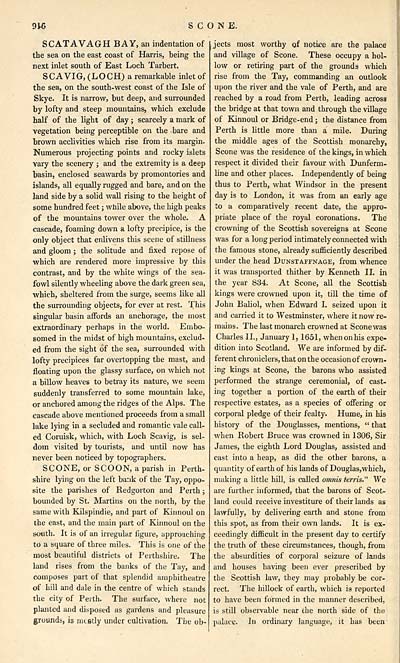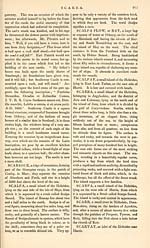Gazetteer of Scotland > Volume 2
(436) Page 916 - SCA
Download files
Complete book:
Individual page:
Thumbnail gallery: Grid view | List view

91-6
SCONE.
SCATAVAGH BAY, an indentation of
the sea on the east coast of Harris, being the
next inlet south of East Loch Tarbert.
SCAVIG,(LOCH) a remarkable inlet of
the sea, on the south-west coast of the Isle of
Skye. It is narrow, but deep, and surrounded
by lofty and steep mountains, which exclude
half of the light of day ; scarcely a mark of
vegetation being perceptible on the bare and
brown acclivities which rise from its margin.
Numerous projecting points and rocky islets
vary the scenery ; and the extremity is a deep
basin, enclosed seawards by promontories and
islands, all equally rugged and bare, and on the
land side by a solid wall rising to the height of
some hundred feet ; while above, the high peaks
of the mountains tower over the whole. A
cascade, foaming down a lofty precipice, is the
only object that enlivens this scene of stillness
and gloom ; the solitude and fixed repose of
which are rendered more impressive by this
contrast, and by the white wings of the sea-
fowl silently wheeling above the dark green sea,
which, sheltered from the surge, seems like all
the surrounding objects, for ever at rest. This
singular basin affords an anchorage, the most
extraordinary perhaps in the world. Embo-
somed in the midst of high mountains, exclud-
ed from the sight of the sea, surrounded with
lofty precipices far overtopping the mast, and
floating upon the glassy surface, on which not
a billow heaves to betray its nature, we seem
suddenly transferred to some mountain lake,
or anchored among the ridges of the Alps. The
cascade above mentioned proceeds from a small
lake lying in a secluded and romantic vale call-
ed Coruisk, which, with Loch Scavig, is sel-
dom visited by tourists, and until now has
never been noticed by topographers.
SCONE, or SCOON, a parish in Perth-
shire lying on the left bank of the Tay, oppo-
site the parishes of Redgorton and Perth ;
bounded by St. Martins on the north, by the
same with Kilspindie, and part of Kinnoul on
the east, and the main part of Kinnoul on the
south. It is of an irregular figure, approaching
to a square of three miles. This is one of the
most beautiful districts ol Perthshire. The
land rises from the banks of the Tay, and
composes part of that splendid amphitheatre
of Bill and dale in the centre of which stands
the city of Perth. The surface, where not
planted and disposed as gardens and pleasure
grounds, is mtstly under cultivation. The ob-
jects most worthy of notice are the palace
and village of Scone. These occupy a hol-
low or retiring part of the grounds which
rise from the Tay, commanding an outlook
upon the river and the vale of Perth, and are
reached by a road from Perth, leading across
the bridge at that town and through the village
of Kinnoul or Bridge-end ; the distance from
Perth is little more than a mile. During
the middle ages of the Scottish monarchy,
Scone was the residence of the kings, in which
respect it divided their favour with Dunferm-
line and other places. Independently of being
thus to Perth, what Windsor in the present
day is to London, it was from an early age
to a comparatively recent date, the appro-
priate place of the royal coronations. The
crowning of the Scottish sovereigns at Scone
was for a long period intimately connected with
the famous stone, already sufficiently described
under the head Dunstaffnage, from whence
it was transported thither by Kenneth II. in
the year 834. At Scone, all the Scottish
kings were crowned upon it, till the time of
John Baliol, when Edward I. seized upon it
and carried it to Westminster, where it now re-
mains. The last monarch crowned at Sconewas
Charles II., January 1, 1651, when on his expe-
dition into Scotland. We are informed by dif-
ferent chroniclers, that on the occasion of crown-
ing kings at Scone, the barons who assisted
performed the strange ceremonial, of cast-
ing together a portion of the earth of their
respective estates, as a species of offering or
corporal pledge of their fealty. Hume, in his
history of the Douglasses, mentions, " that
when Robert Bruce was crowned in 1306, Sir
James, the eighth Lord Douglas, assisted and
cast into a heap, as did the other barons, a
quantity of earth of his lands of Douglas, which,
making a little hill, is called omnis terris." We
are further informed, that the barons of Scot-
land could receive investiture of their lands as
lawfully, by delivering earth and stone from
this spot, as from their own lands. It is ex-
ceedingly difficult in the present day to certify
the truth of these circumstances, though, from
the absurdities of corporal seizure of lands
and houses having been ever prescribed by
the Scottish law, they may probably be cor-
rect. The hillock of earth, which is reported
to have been formed in the manner described,
is still observable near the north side of the
palace. In ordinary language, it has been
SCONE.
SCATAVAGH BAY, an indentation of
the sea on the east coast of Harris, being the
next inlet south of East Loch Tarbert.
SCAVIG,(LOCH) a remarkable inlet of
the sea, on the south-west coast of the Isle of
Skye. It is narrow, but deep, and surrounded
by lofty and steep mountains, which exclude
half of the light of day ; scarcely a mark of
vegetation being perceptible on the bare and
brown acclivities which rise from its margin.
Numerous projecting points and rocky islets
vary the scenery ; and the extremity is a deep
basin, enclosed seawards by promontories and
islands, all equally rugged and bare, and on the
land side by a solid wall rising to the height of
some hundred feet ; while above, the high peaks
of the mountains tower over the whole. A
cascade, foaming down a lofty precipice, is the
only object that enlivens this scene of stillness
and gloom ; the solitude and fixed repose of
which are rendered more impressive by this
contrast, and by the white wings of the sea-
fowl silently wheeling above the dark green sea,
which, sheltered from the surge, seems like all
the surrounding objects, for ever at rest. This
singular basin affords an anchorage, the most
extraordinary perhaps in the world. Embo-
somed in the midst of high mountains, exclud-
ed from the sight of the sea, surrounded with
lofty precipices far overtopping the mast, and
floating upon the glassy surface, on which not
a billow heaves to betray its nature, we seem
suddenly transferred to some mountain lake,
or anchored among the ridges of the Alps. The
cascade above mentioned proceeds from a small
lake lying in a secluded and romantic vale call-
ed Coruisk, which, with Loch Scavig, is sel-
dom visited by tourists, and until now has
never been noticed by topographers.
SCONE, or SCOON, a parish in Perth-
shire lying on the left bank of the Tay, oppo-
site the parishes of Redgorton and Perth ;
bounded by St. Martins on the north, by the
same with Kilspindie, and part of Kinnoul on
the east, and the main part of Kinnoul on the
south. It is of an irregular figure, approaching
to a square of three miles. This is one of the
most beautiful districts ol Perthshire. The
land rises from the banks of the Tay, and
composes part of that splendid amphitheatre
of Bill and dale in the centre of which stands
the city of Perth. The surface, where not
planted and disposed as gardens and pleasure
grounds, is mtstly under cultivation. The ob-
jects most worthy of notice are the palace
and village of Scone. These occupy a hol-
low or retiring part of the grounds which
rise from the Tay, commanding an outlook
upon the river and the vale of Perth, and are
reached by a road from Perth, leading across
the bridge at that town and through the village
of Kinnoul or Bridge-end ; the distance from
Perth is little more than a mile. During
the middle ages of the Scottish monarchy,
Scone was the residence of the kings, in which
respect it divided their favour with Dunferm-
line and other places. Independently of being
thus to Perth, what Windsor in the present
day is to London, it was from an early age
to a comparatively recent date, the appro-
priate place of the royal coronations. The
crowning of the Scottish sovereigns at Scone
was for a long period intimately connected with
the famous stone, already sufficiently described
under the head Dunstaffnage, from whence
it was transported thither by Kenneth II. in
the year 834. At Scone, all the Scottish
kings were crowned upon it, till the time of
John Baliol, when Edward I. seized upon it
and carried it to Westminster, where it now re-
mains. The last monarch crowned at Sconewas
Charles II., January 1, 1651, when on his expe-
dition into Scotland. We are informed by dif-
ferent chroniclers, that on the occasion of crown-
ing kings at Scone, the barons who assisted
performed the strange ceremonial, of cast-
ing together a portion of the earth of their
respective estates, as a species of offering or
corporal pledge of their fealty. Hume, in his
history of the Douglasses, mentions, " that
when Robert Bruce was crowned in 1306, Sir
James, the eighth Lord Douglas, assisted and
cast into a heap, as did the other barons, a
quantity of earth of his lands of Douglas, which,
making a little hill, is called omnis terris." We
are further informed, that the barons of Scot-
land could receive investiture of their lands as
lawfully, by delivering earth and stone from
this spot, as from their own lands. It is ex-
ceedingly difficult in the present day to certify
the truth of these circumstances, though, from
the absurdities of corporal seizure of lands
and houses having been ever prescribed by
the Scottish law, they may probably be cor-
rect. The hillock of earth, which is reported
to have been formed in the manner described,
is still observable near the north side of the
palace. In ordinary language, it has been
Set display mode to: Large image | Transcription
Images and transcriptions on this page, including medium image downloads, may be used under the Creative Commons Attribution 4.0 International Licence unless otherwise stated. ![]()
| Gazetteers of Scotland, 1803-1901 > Gazetteer of Scotland > Volume 2 > (436) Page 916 - SCA |
|---|
| Permanent URL | https://digital.nls.uk/97436054 |
|---|
| Description | Volume II: Glenbanchor to Zetland. |
|---|---|
| Attribution and copyright: |
|
| Description | By Robert Chambers and William Chambers. Glasgow: Blackie & Son, 1838. 2 volumes. |
|---|---|
| Shelfmark | NF.1461.g.7 |
| Additional NLS resources: | |

